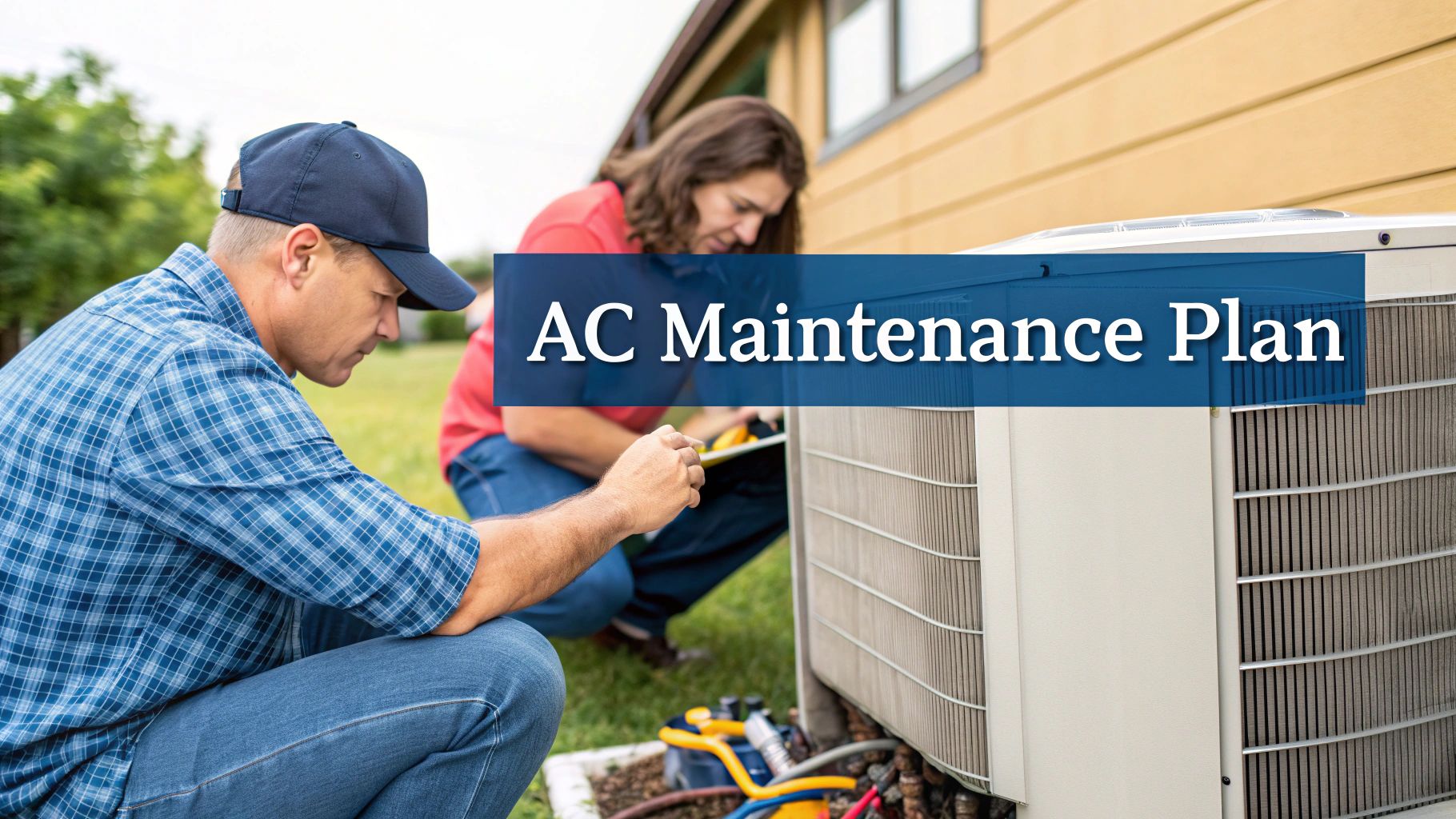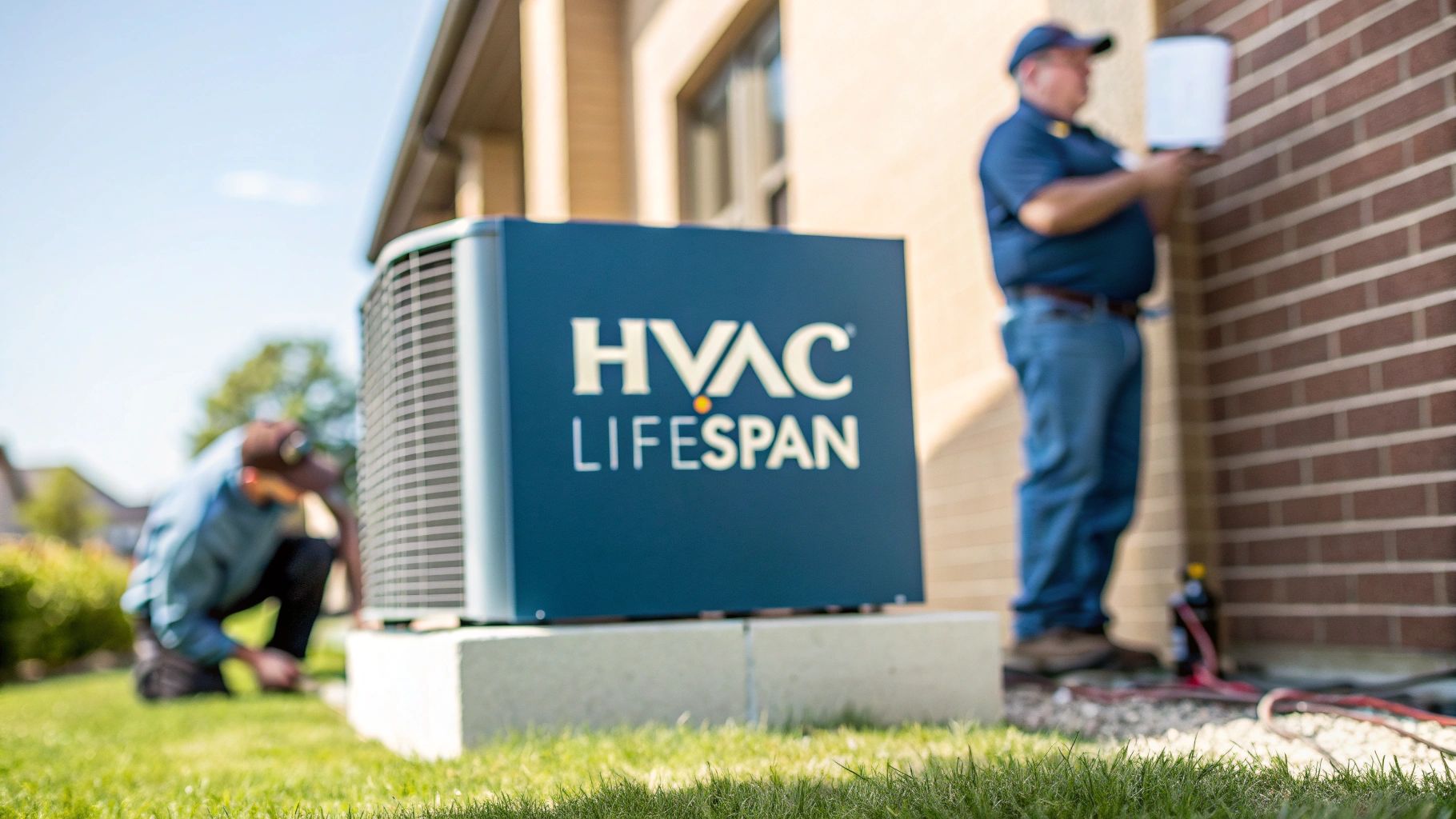When your AC starts blowing warm air, especially on a sweltering day, panic can set in pretty quickly. But before you assume the worst, take a deep breath. Often, the cause is surprisingly simple. The most common culprits are usually a wrong thermostat setting, a clogged air filter, or a refrigerant leak.
These problems run the gamut from a five-minute fix you can easily handle yourself to issues that definitely need a professional's touch.
Your Quick Diagnostic Guide for a Warm Air Problem
Let's walk through the most likely reasons your AC isn't cooling. Think of this as your first-response checklist to figure out what's going on and get that cool air flowing again.
This visual guide breaks down the top three reasons for a warm air problem, helping you quickly identify the most likely suspect.
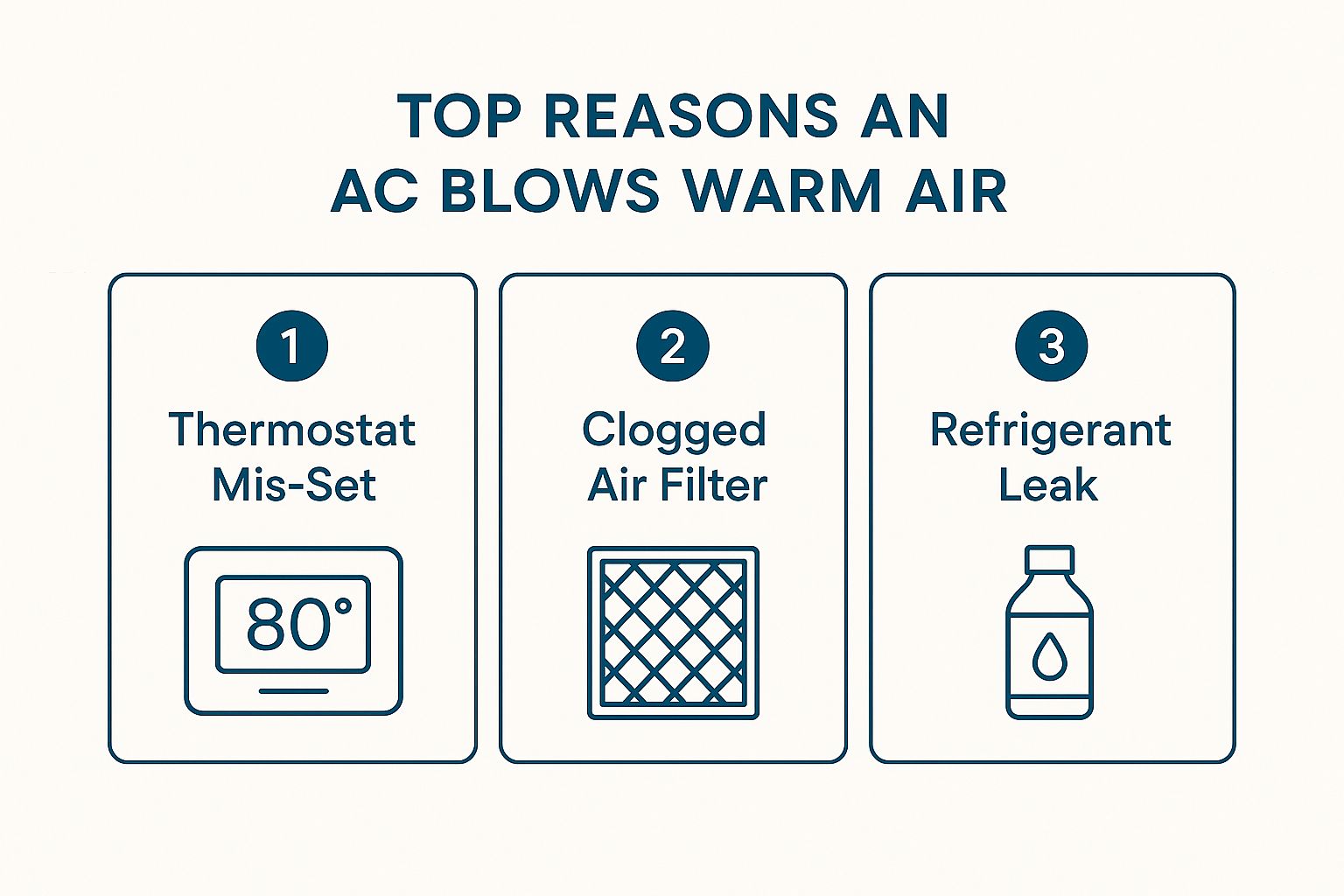
As you can see, sometimes it’s just a simple oversight or a bit of basic maintenance standing between you and a cool home. In fact, industry data shows that up to 10% of all service calls are for this exact issue—systems blowing warm air. With the residential AC market expected to reach $72 billion by 2025, it’s a problem millions of homeowners face.
Common Reasons an AC Blows Warm Air
Here's a quick summary table to help you narrow down the issue and decide on your next steps.
| Likely Cause | DIY or Professional Fix? | First Step to Take |
|---|---|---|
| Incorrect Thermostat Setting | DIY | Check that the thermostat is set to "Cool" and the temperature is lower than the current room temp. |
| Dirty or Clogged Air Filter | DIY | Inspect the air filter. If it's dirty, replace it with a new one. |
| Low Refrigerant Levels | Professional | Look for signs of a leak (hissing, frozen coils) and call an HVAC technician. |
This table gives you a starting point. By tackling the easy stuff first, you can often solve the problem without having to make a service call.
If you've checked these common failure points and are still stuck, it might be time to look a little deeper. For a more comprehensive look at what could be wrong, check out our complete air conditioning troubleshooting guide. It will help you decide if it's a DIY job or time to call in the pros.
Start with These Simple DIY Fixes
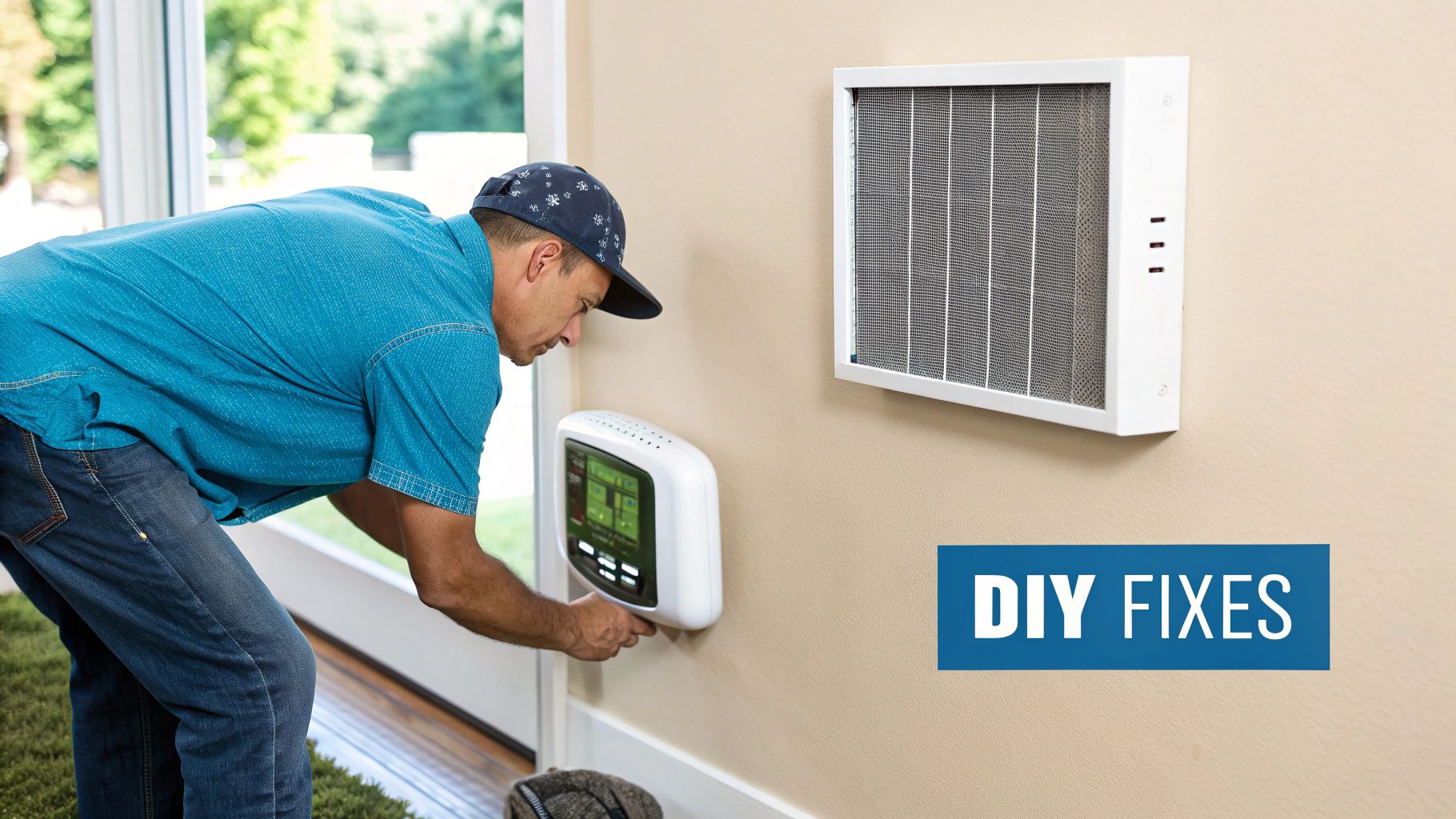
Before you pick up the phone and schedule an expensive service call, let’s run through a few common issues you can probably fix yourself. More often than not, an air conditioner blowing warm air isn't a sign of a catastrophic failure. It's usually something simple you can sort out in just a few minutes.
First things first, check the thermostat. It sounds almost silly, but you'd be surprised how often someone in the house accidentally bumps the settings. They might have switched it to "Heat" by mistake or set the fan to "On" instead of "Auto," which means the fan will run constantly, even when the cooling cycle is off.
Quick Thermostat Check
Make sure your thermostat is set to "Cool" and the temperature is at least five degrees lower than what the room is currently at. Also, double-check that the fan is set to "Auto," not "On."
Inspect Your Air Filter
If the thermostat is set correctly, the next likely culprit is a dirty air filter. A clogged filter essentially chokes your AC system. It can't pull in enough air, which severely limits its ability to cool your home.
This lack of airflow can cause the indoor evaporator coils to get so cold that they actually freeze over—a classic reason for an AC to start blowing warm air. The good news? This is one of the easiest and cheapest problems to solve.
Here's how to check it out:
- Locate the Filter: You'll usually find it in the indoor air handler unit or tucked inside the main return air vent in your wall or ceiling.
- Inspect for Dirt: Pull the filter out. A good rule of thumb is to hold it up to a light source. If you can’t see the light through it, it’s long overdue for a change.
- Replace if Needed: Pop in a new filter of the same size. Just be sure the arrows on the side of the new filter are pointing in the direction of the airflow.
Keeping a clean filter in your system doesn't just help it cool better; it also boosts efficiency and improves your home's air quality. While you're at it, keeping the coils clean is also a big deal for performance. You can find more info on how to clean air conditioning coils to keep things running smoothly.
Last but not least, take a look at your circuit breaker panel. Your AC system typically has two breakers—one for the indoor unit and another for the outdoor condenser. If the breaker for the outdoor unit has tripped, it can't do its job of releasing heat from your home. A simple flip of the switch could be all it takes to get that cool air flowing again.
Inspect and Clean Your Outdoor Condenser Unit
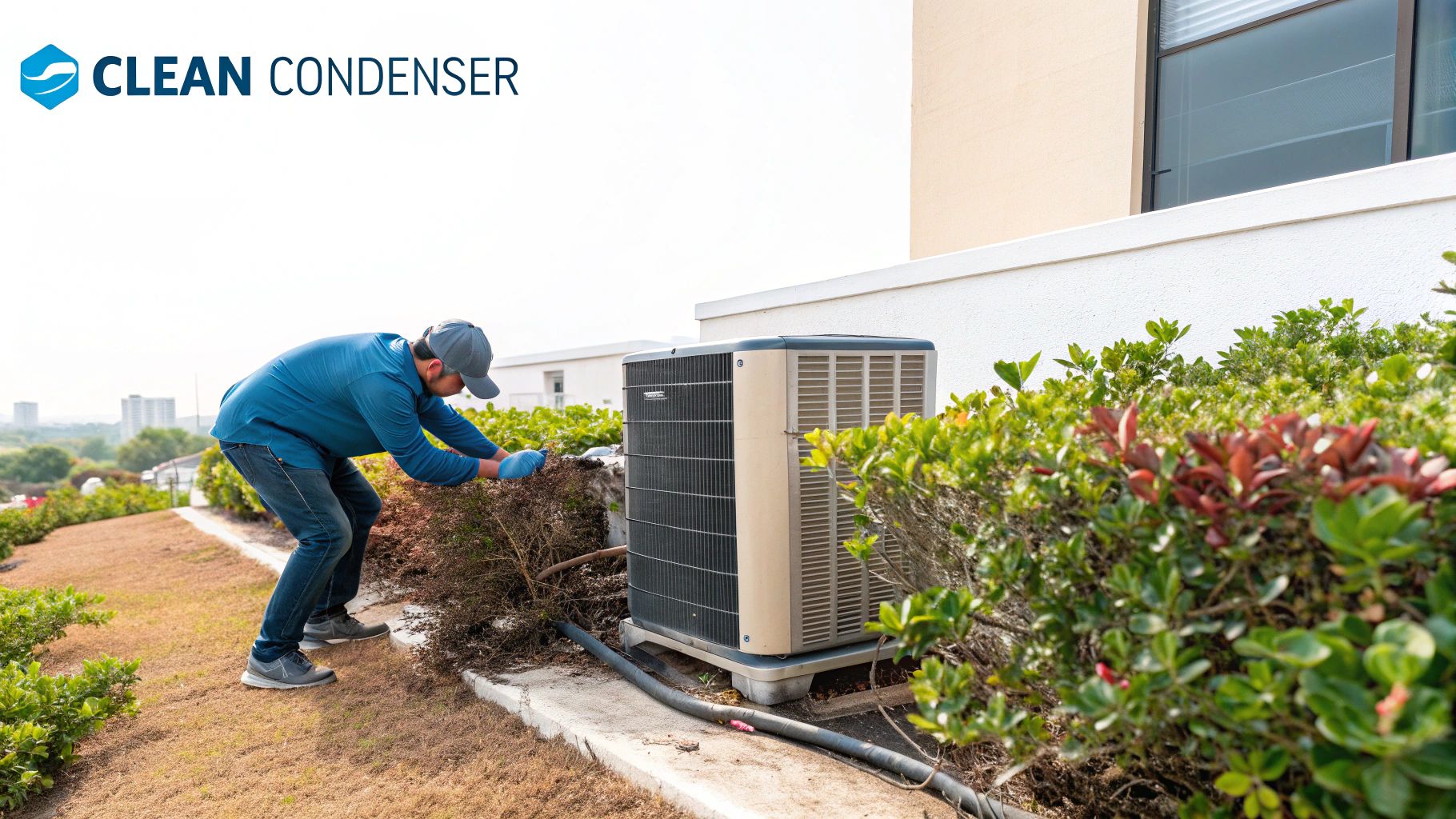
Your air conditioner is a team, with an indoor unit and an outdoor unit working together. The whole job of that big, boxy unit outside—the condenser—is to dump all the heat it has pulled from your home into the air. If it gets clogged with dirt, leaves, or grass clippings, it can't breathe.
It's a lot like a car radiator getting packed with mud. It just can't get rid of heat efficiently, and that trapped heat has nowhere to go but back into your system. This is a surprisingly common reason why an AC is blowing warm air.
The good news? A little bit of simple cleaning can often get things back to normal.
How to Safely Clean Your Condenser
First things first: safety. You're going to be working around electricity and some pretty delicate metal fins, so cutting the power is a must.
- Turn Off the Power: Look for the electrical disconnect box near the outdoor unit, usually a metal box on the wall. Open it up and either pull the disconnect block straight out or flip the switch to "Off." To be extra safe, I always recommend flipping the corresponding breaker in your main electrical panel, too.
- Clear Away Debris: Start with the easy stuff. Pull away any big debris like leaves, twigs, and grass by hand. Don't forget to check the base of the unit and the space between it and your house.
- Gently Clean the Fins: Those thin metal fins all around the unit are the key to releasing heat. Use a soft brush or just a regular garden hose on a gentle setting to wash away all the caked-on dirt. Never use a pressure washer for this; the powerful stream will bend those delicate fins in a heartbeat, causing a much bigger problem.
Crucial Clearance for Airflow
Your outdoor condenser needs room to work. Make sure there’s at least two feet of clear space all the way around it. Trim back any bushes, hedges, or weeds that are getting too close and suffocating your AC.
Once the unit looks clean and has had a few minutes to dry, go ahead and restore the power. Put the disconnect back in and flip the breaker on. Now for the moment of truth: head inside, set your thermostat to cool, and see if your hard work paid off.
Understanding the Role of Refrigerant
If you’ve tried the simple fixes and your AC is still blowing warm air, the problem might be your system's refrigerant. You can think of refrigerant as the magic ingredient in your air conditioner. It’s a special compound that cycles through the AC coils, pulling heat out of your indoor air and dumping it outside.
When everything is working right, this heat exchange process is what delivers that wonderful cool air. But if the refrigerant level is too low, the system just can't grab enough heat, and you get warm air out of your vents.
Here's something crucial to understand: your AC doesn't "use up" refrigerant like a car uses gas. If you're low on refrigerant, it means there's a leak somewhere in the system. This is a big deal. A unit that's low on refrigerant can lose 30–50% of its cooling power, making it work overtime and driving up your energy bills. You can learn more about how AC efficiency impacts energy consumption at ourworldindata.org.
Signs of a Refrigerant Leak
Thankfully, you don't have to be a professional to spot the clues of a refrigerant leak. Your system will often give you some pretty clear warning signs that something is wrong.
Keep an eye (and ear) out for these red flags:
- A distinct hissing or bubbling noise coming from the AC unit or its copper lines.
- Ice or frost building up on the refrigerant lines, especially on the larger copper pipe connected to the outdoor unit.
- The AC seems to run all the time but never actually cools your home down.
A refrigerant leak isn’t a DIY job. Handling refrigerant is tightly regulated for safety and environmental reasons, and it requires special tools and certification. A technician needs to find the leak, fix it properly, and then add the precise amount of refrigerant back into the system.
Just adding more refrigerant without fixing the source of the leak is a temporary, costly, and often illegal band-aid. For more ways to keep your system running smoothly, take a look at our guide on top AC refrigeration tips for year-round comfort.
Deeper Mechanical and Electrical Failures
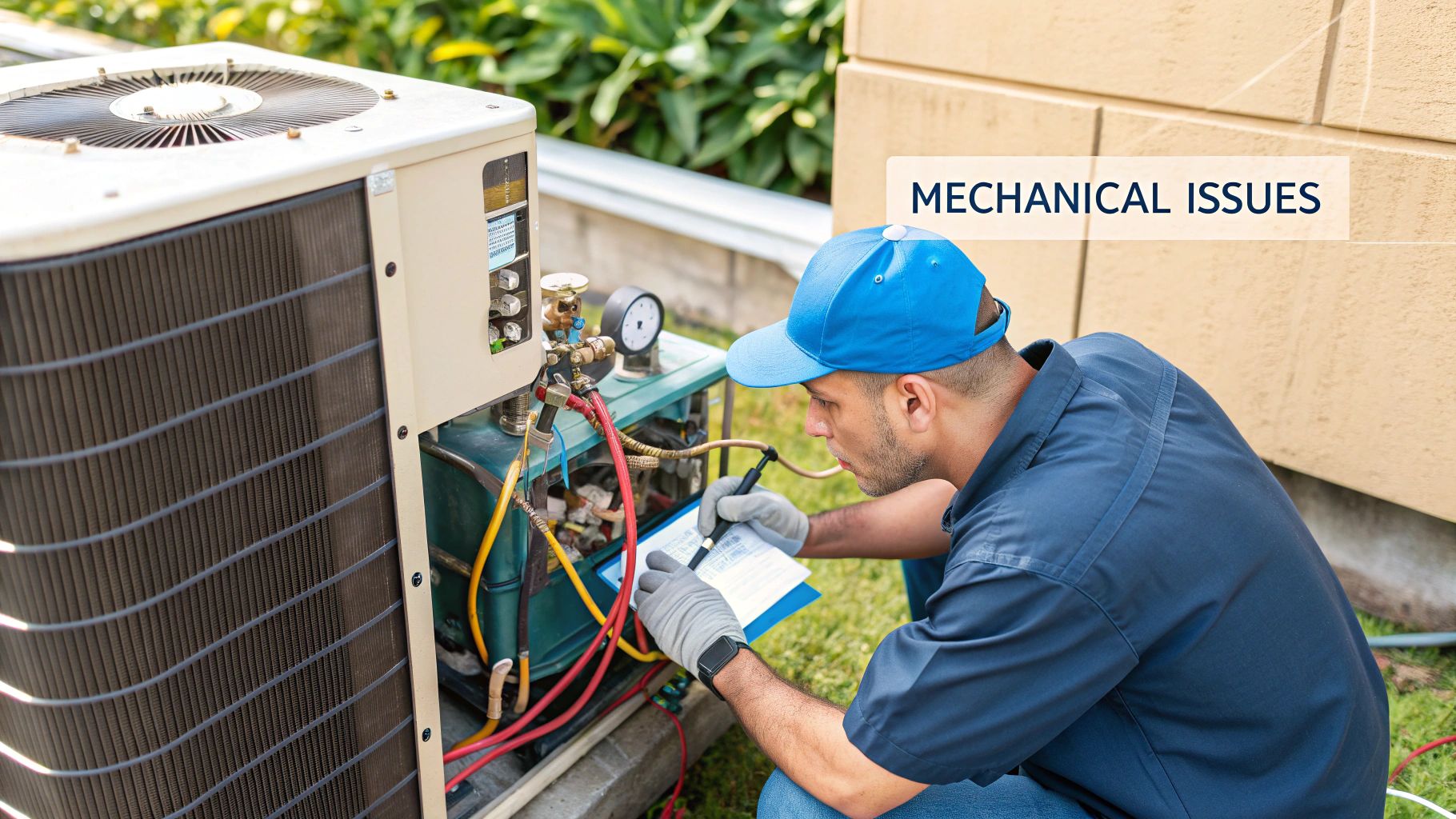
So, you've checked the easy stuff and you're pretty sure it's not a refrigerant leak. Now we're getting into the real heart of the machine. When your AC is blowing warm air because of a more serious problem, it usually points to a mechanical or electrical failure that’s best left to a pro. Knowing what these parts do can help you understand what a technician is looking for.
The Compressor: Your AC's Engine
Think of the compressor as the engine of your entire cooling system. It sits in that big outdoor unit and its job is to put the refrigerant under intense pressure, pumping it through the coils to move heat from inside your house to the outside. If the compressor dies, the whole process stops cold.
How can you tell if the compressor is in trouble? It often makes a racket. Listen for loud, strange noises like rattling, clanking, or even violent shaking when the unit tries to power on.
The Problem with Frozen Evaporator Coils
Another major headache is a frozen evaporator coil. This is the part inside your home that absorbs the heat from the air. When it ices over, it turns into a solid block of ice, and no air can get through to be cooled.
This usually happens for two reasons: a severely clogged air filter or low refrigerant. While changing a filter is simple, a frozen coil that results from it might need a professional to safely thaw everything out and check for any underlying damage.
Why Frozen Coils Cause Warm Air
When the evaporator coil is a block of ice, air can't pass through it. The air simply goes around the icy mess and blows out of your vents at whatever the room temperature is, which feels warm.
Finally, a surprisingly common culprit is a failed capacitor. This is a small, can-shaped part that gives the motors a jolt of electricity to get started, kind of like a battery for a quick boost. When a capacitor goes bad, the compressor and fan motors can't get the kickstart they need, and your system won't run at all.
Even in a global HVAC market valued at $263.6 billion in 2023, it’s often these small, critical parts that bring a powerful system to a halt. You can find more HVAC industry insights on bccresearch.com.
Knowing When to Call an HVAC Professional
Being a savvy homeowner means knowing when to tackle a problem yourself and when to call in the pros. While you can handle many simple AC issues with a bit of troubleshooting, digging into complex electrical or mechanical parts without training is a recipe for disaster. It can be dangerous and often makes the problem worse.
If you’ve run through the basic checks and your AC is still pumping out warm air, it's a clear sign that it's time to bring in an expert.
Red Flags That Mean You Need an Expert
Some problems are simply not DIY-friendly. If you spot any of these warning signs, your best bet is to pick up the phone and call a technician right away.
-
Loud, Unsettling Noises: If you hear any loud grinding or squealing, it's a huge red flag. These sounds often point to a serious mechanical failure, like worn-out bearings or a compressor that's on its last legs.
-
Constant Breaker Tripping: Does your AC unit trip the circuit breaker every time it tries to kick on? This isn't a simple reset-and-forget issue; it signals a deeper electrical problem that needs a professional to diagnose safely.
-
Signs of a Refrigerant Leak: If you notice a hissing sound near your unit or see ice building up on the refrigerant lines, you almost certainly have a leak. Only a certified technician is legally allowed to handle refrigerants, so this is a definite hands-off situation.
In the end, if you've done everything you can and the cool air still hasn't returned, that's your cue. When your best efforts don't fix the issue, it’s time to seek out professional AC repair services to get to the root of the problem.
Got Questions About Your AC? We've Got Answers.
When your AC starts acting up, it’s natural to have a few questions. Let's tackle some of the most common ones homeowners ask when their system stops cooling.
How Often Should I Really Change My AC Filter?
For a standard 1-inch filter, the general advice is to change it every 1 to 3 months. But honestly, that’s just a starting point.
Think of it this way: if you have pets shedding dander, family members with allergies, or live in a dusty area, you’ll want to check that filter every month. A clogged filter is hands down the most common—and most preventable—cause of AC problems.
Why Is There Ice on My AC Lines?
Seeing ice on your AC lines might look strange, but it’s a classic sign of a problem. It almost always points to one of two things: either airflow is being choked off (hello again, dirty filter!) or your system is low on refrigerant.
When airflow is weak or refrigerant is low, the evaporator coils get way too cold, and the condensation on them flash-freezes. If you see ice, turn the AC off immediately to let it thaw. After it's melted, change the filter. If the ice comes back, it's time to call a professional.
An icy buildup often signals a more serious issue, because a healthy AC system is a closed loop and shouldn't lose refrigerant. If you're dealing with inconsistent temperatures, you might find some answers in our detailed guide on why your HVAC system might be blowing warm or cold air when it shouldn't.
When you've tried the simple fixes and still aren't getting cold air, you need an expert you can count on. The certified professionals at Florida Cooling Group are ready 24/7 to diagnose and solve any AC issue. Visit us at https://floridacoolinggroup.com to schedule your service today.

 (561) 400-2205
(561) 400-2205
